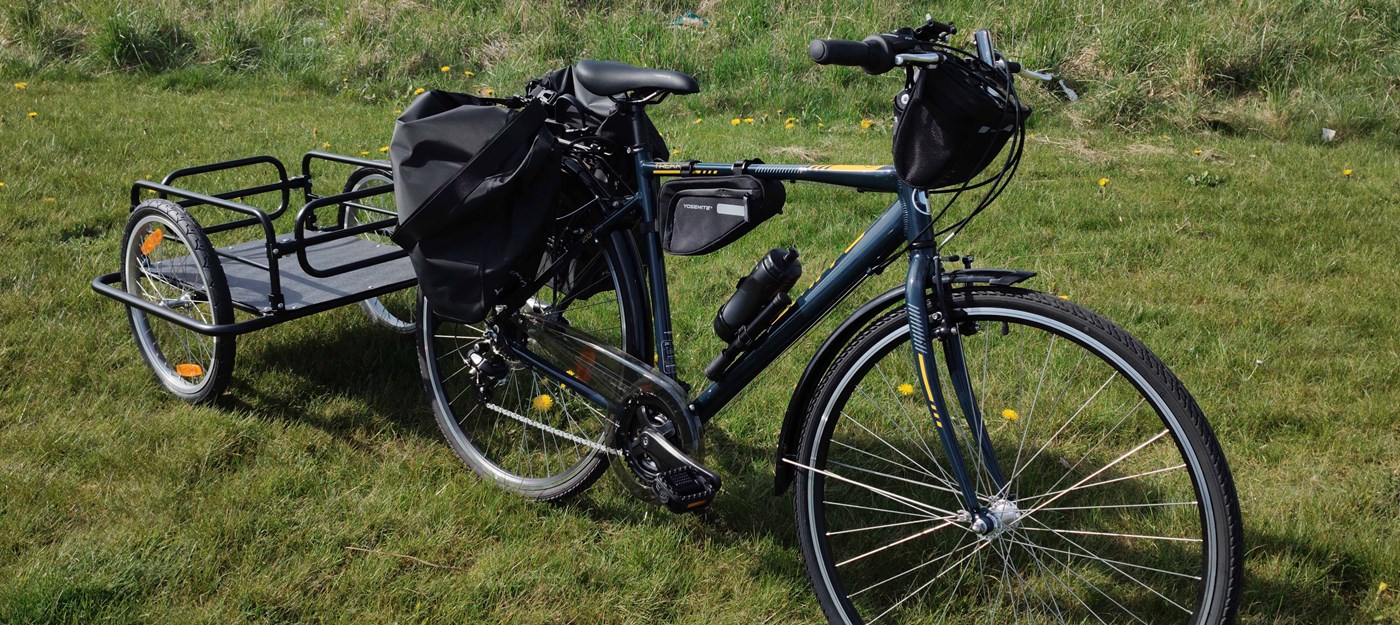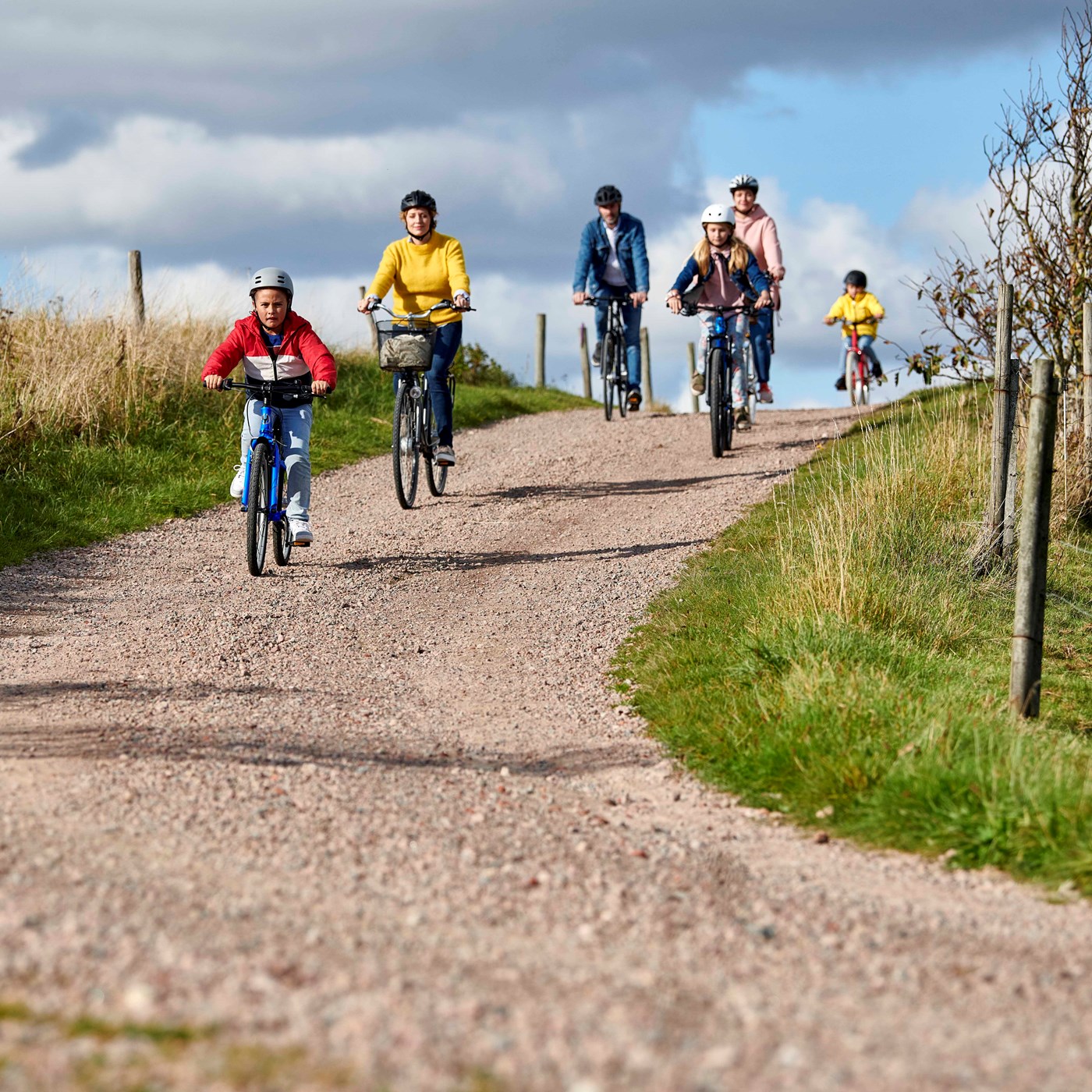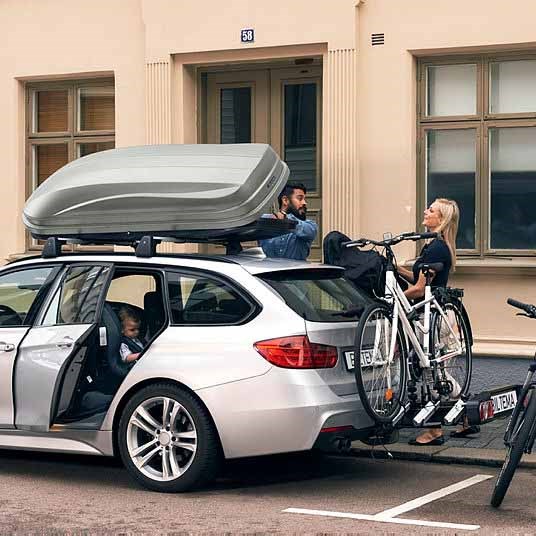Ready for a cycling holiday? Get answers to everything here
But the experience depends on how well you prepare. Being well prepared is essential for getting the most out of your cycling holiday. In this guide, we’ll go through everything you need to know to plan a great bike ride, from choosing the right bike and equipment to overnighting options, packing lists, and specific tips for a cycling holiday with kids.
We will also offer advice on cooking, hygiene, and other important aspects to ensure a comfortable and unforgettable cycling holiday. Read more below and get well prepared to enjoy many hours on your bike and have plenty of good experiences on your next cycling holiday.

Things to consider on a cycling holiday with children
Before we dive into everything you need to know before departing on your cycling holiday, it’s important to consider the differences between cycling holidays with and without children. There are extra things to consider when taking your children on a longer bike ride.
Going on a cycling holiday with children can be an incredibly rewarding and fun experience for the whole family. But it also requires a little extra planning and consideration to ensure that the trip is a success. Read on below about what to consider.
- Route: When choosing a route, it is important to take into account the age and fitness of the children. Avoid stretches that are too long and make sure to include breaks along the way so the kids don’t get too tired. Plan the route to include interesting stops and sights to spark the children’s curiosity and keep them motivated. It’s also a good idea to choose signposted cycling routes to cycle as safely as possible.
- Safety: The safety of children is paramount during a cycling holiday. Invest in helmets and reflectors for the kids, and go through the traffic rules with them and other things they should be aware of so that they know how to behave on the road. Also, bring a first aid kit so that you are prepared for any minor injuries.
- Equipment: If the children are too young to ride their own bike, consider a bike trailer, a child bike seat, or a “follow-me” tandem hitch. These solutions make it easier and more fun for children to participate in the cycling holiday and ensure that the whole family can enjoy the ride together.
- Entertainment: Prepare some entertaining activities for kids during breaks and overnight stays, such as board games, books, exploring/guessing games, or anything else that holds their interest and creates good memories together. It’s up you whether you want to bring an iPad or other electronic devices along.
- Flexibility: Be prepared to change plans if the children get tired or the weather is not optimal. It’s important to maintain a positive attitude and ensure that everyone has fun. Be open to spontaneous changes in the route or schedule, and remember that the purpose of a cycling holiday is to enjoy time together as a family.
By taking these considerations into account when planning your cycling holiday with children, you can create an unforgettable and fun experience for the whole family. With a little extra planning and preparation, you’ll be ready to explore the world on two wheels.
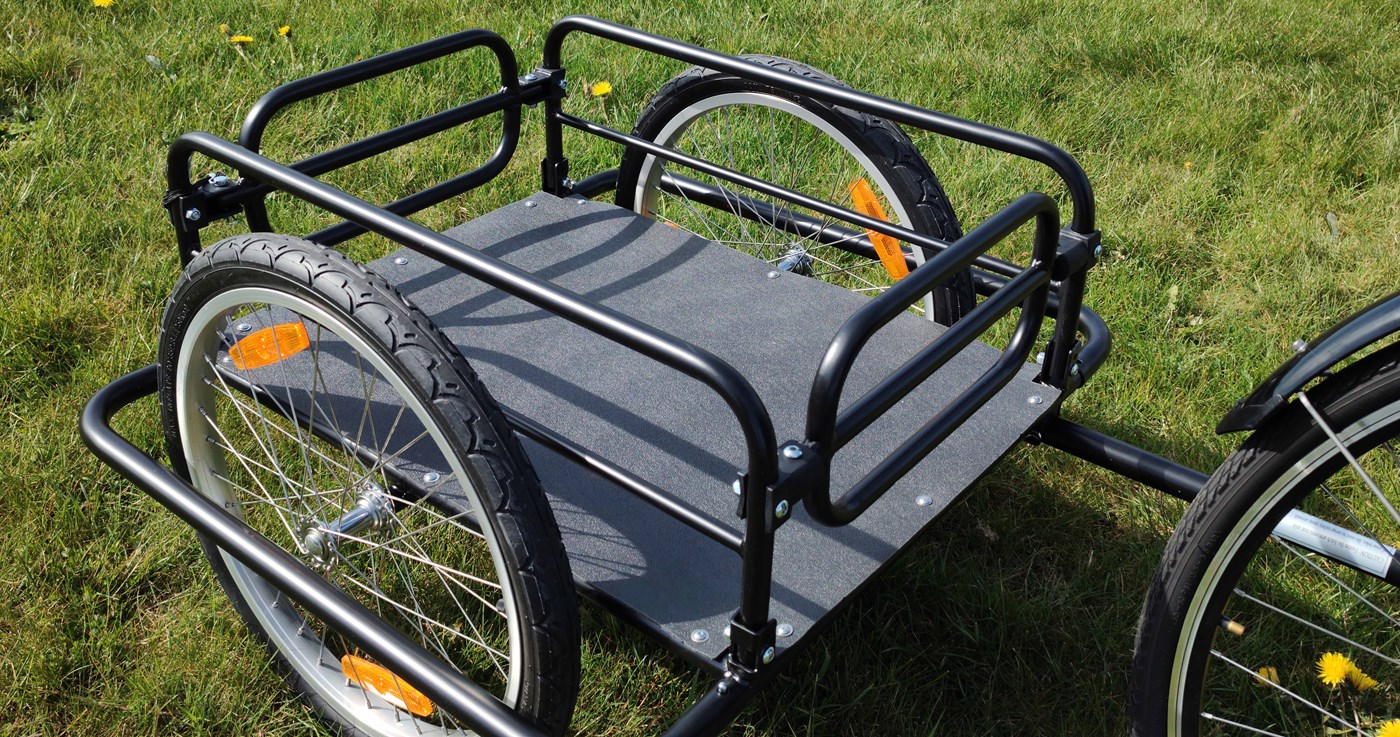
Choosing a bike and preparing for your cycling holiday
Choosing the right bike for your cycling holiday is crucial, regardless of whether you are planning a cycling holiday in Denmark, Europe or elsewhere.
You can start by looking at your current bike and consider whether it is fit for purpose. Is it a dependable city bike, a fast racing bike, or a versatile mountain bike? Remember that different types of bikes are better suited to different terrains and routes.
Once you’ve assessed your bike, make sure it’s in top condition and ready for a long bike ride. Check the handlebars, saddle, and height to make sure they fit your body perfectly. This will ensure a comfortable and gentle ride for your back, arms, and legs. The bike must also be well-oiled and maintained so that it is ready to roll without problems. Check tyre pressure, brakes, and gears and make sure they are working optimally.
If your current bike is not suitable for the ride, consider investing in a new bike for your cycling holiday. You won’t get far if you have an old run-down bike, and your experience will be significantly worse if your bike prevents you from getting from A to B.
At Biltema we have a large selection of bikes to ensure that you have a successful cycling holiday. You can see a selection below and browse the full range of bikes here.
We’ve also written a guide to help you choose your next bike.
Also, don’t forget safety equipment such as a helmet,
By choosing the right bike and preparing well, you will give yourself the best conditions for a comfortable, safe, and unforgettable cycling holiday.
When you need to stay overnight on your cycling holiday
Whether you are on a cycling holiday with children or alone, overnighting is an important part of planning. Consider different options such as camping, hostels, and hotels in both Denmark and the rest of Europe. To choose the best option, consider the time of year, weather, and your personal preferences.
If you are looking for nature experiences and want to be close to nature, camping can be a great option. You can bring a tent, sleeping bag, and sleeping mat, just make sure they are suitable for the destination, the season, and the weather. Remember to opt for a lightweight tent for longer trips, and try use sheltered sites where available. If you decide on camping, it gives you great freedom and flexibility to visit many places, but it also requires more preparation and you need to pack more gear.
Hostels are a budget-friendly and social accommodation option found in many cities across Denmark and Europe. They often offer dormitories and private rooms, as well as shared facilities such as a kitchen, lounge, and laundry rooms. Hostels are a good solution for those who want a combination of comfort and economy, as well as the opportunity to meet other travellers.
If you take children on a cycling holiday, they can benefit greatly from meeting other children at a campsite or hostel. And maybe parents can get a much-needed break. In general, if you’re on a cycling holiday with children, think twice and make sure accommodations are child-friendly and offer amenities like playgrounds, cots, and extra beds. This will make your cycling holiday much better for the whole family.
Bed and breakfasts, inns, and hotels offer more privacy and comfort compared to camping and hostels. They vary in price and standard, but allow you to enjoy a soft bed, hot shower, and often a delicious breakfast.
Whichever accommodation option you choose, it’s important to plan ahead and book well in advance, especially during high season. This ensures that you get the best experience and can enjoy your cycling holiday without worrying about where to sleep. When you plan your accommodation well in advance, you can enjoy your cycling holiday with peace of mind.
Transporting belongings during your cycling holiday
When packing for your cycling holiday, it is important to have a practical packing list that covers everything you need on either a short or long cycling holiday. Consider using panniers or bikepacking bags to transport your belongings. Waterproof bags are a good investment, especially when cycling in rainy areas. There is nothing worse than all your stuff getting soaked.



Waterproof bags are a great advantage when cycling in areas with fluctuating weather. They protect your gear and clothing from rain and dirt and make it easier to keep your things dry and clean. An alternative to waterproof bags is to cover your bags with rain covers.
Bike panniers that attach to the rack are ideal for carrying heavier and larger items such as a tent, sleeping bag, and cooking equipment. They provide a stable ride and can be easily attached and removed when you arrive at your destination. Pay attention to the weight distribution and be sure to balance the load on both sides of the bike to avoid imbalance and potentially crashing.
Bikepacking bags are designed to be strapped directly to the bike frame, and are suitable for lightweight and minimalist travel. They are often smaller and more aerodynamic than classic panniers, making them ideal for off-road and rough terrain. Bikepacking bags come in different sizes and shapes, and can be placed on different parts of the bike, such as the saddle post, frame, and handlebars.
It is important to pack tools and spare parts, such as patching gear, spare inner tube, and tyre iron, as well as a small pump and multitool with the necessary Allen keys and screwdrivers. Make sure you have easy access to these tools and parts so you can quickly make repairs along the path. It’s also a good idea to practise at home so you know how to actually patch your bike should an accident occur.
Finally, keep in mind that less is often more when it comes to packing for a cycling holiday. Take only the necessities and leave unnecessary items at home. This will make your cycling holiday more comfortable and it will be easier to handle your gear on the trip.
There is no such thing as bad weather, only bad clothing
Bad weather can quickly make a bike ride less comfortable, so it’s important that you prepare for all possible scenarios. That is, everything from the hot sun to heavy rainfall. A packing list for your cycling holiday should therefore include clothing or attire that is suitable for the expected weather and that can handle changing temperatures and conditions.
So make sure to choose clothing that is both rainproof or waterproof and breathable, and which can be used in both cold and hot conditions to help keep you comfortable, no matter if you’re sweating or exposed to lower temperatures.
- It is important to have several layers of clothing that can be put on and taken off as needed. Start with a breathable and moisture-wicking base layer that will help keep you dry and warm.
- Next, you’ll need an insulating layer, such as a light fleece or down jacket, to keep you warm when temperatures drop.
- Finally, wear an outer layer that protects against wind and rain, such as a wind- and waterproof jacket and pair of trousers.
For your legs, it’s a good idea to have cycling shorts or trousers that provide padding and comfort. Also remember rain trousers.
For your feet, it’s important to have cycling shoes or good hiking shoes that provide both comfort and support throughout the ride. Pack a pair of waterproof socks as well as extra pairs of regular socks, preferably in merino wool, to ensure your feet stay dry and warm. You can also buy a pair of shoe covers that you can quickly put over your shoes if it rains. They are lighter than rubber boots.
Accessories such as gloves, a cap and a scarf may also be needed, depending on weather conditions. In sunny weather, it’s important to remember sunscreen, sunglasses, and a hat or cap to protect yourself from the sun’s rays.
Packing the right clothing and preparing for different weather conditions is crucial for any good active holiday, whether by bike or other means.
Have the right emergency repair tool on your cycling holiday
To ensure a trouble-free cycling holiday for you and your family, it’s important to be well prepared for unforeseen events and especially for equipment problems. To do that, you’ll need to have the necessary tools, emergency repair kits, and small aids like clamps and strips so you can quickly fix anything that breaks.
Start by packing a basic set of tools for your cycling holiday. This should include:
- Allen wrenches in different sizes to adjust the parts of the bike
- Tyre iron to remove the tyre from the rim
- Pump to maintain tyre pressure
- Patching kit to repair punctures
- A spare inner tube in case of irreparable damage to the tyre
It’s also a good idea to bring a headlamp or head torch in case you need to repair a puncture or make other adjustments after dark.
In addition to the tool kit, it is useful to have clamps and strips to attach equipment and make small repairs along the trip. Elastic bands with hooks and reusable strips are inexpensive. You will find both at Biltema.
They can be used for a wide variety of purposes, such as attaching extra clothing, repair equipment, or packed lunches to the bike, holding cables in place, or holding together parts that have come loose during the ride. There’s practically nothing that can’t be fixed with strips and rubber bands.
In addition to these necessities, it may be a good idea to bring some kind of multitool with tools such as screwdriver, pliers, and knife, in order to cope with unforeseen situations.
A small first aid kit with dressings, patches, scissors, and painkillers is also important to have so you can tend minor injuries and discomfort during the trip.
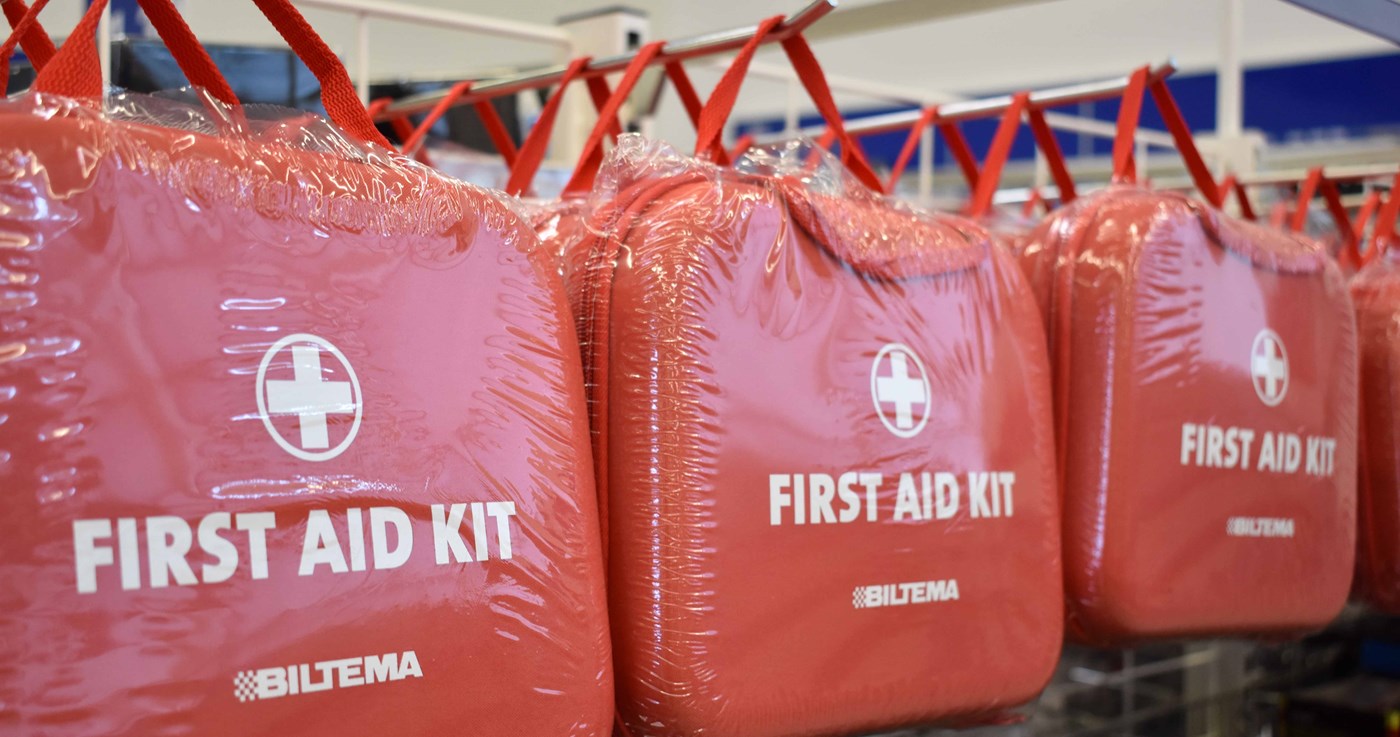
First aid - Equipping yourself with the right tools, repair kits, and small aids will go a long way towards a successful cycling holiday.
Fluids and food are essential for a successful cycling holiday
On a cycling holiday, staying hydrated and energised is crucial to being able to perform at your best and enjoy the ride. After all, you’re the one who must propel the bike, and unless you have an electric bike, you’ll burn a lot of energy.
To make sure you get enough fluids during your bike ride, plan how far you’ll cycle between drink breaks, and make sure you bring enough water. Water bottles can be attached to your bike using bottle holders or frame brackets so they are always within reach.
Check maps and directions to find out how often you can fill up your bottle along the way, and remember that you should drink more in warmer climates and during intense physical exertion. If you are on a cycling holiday in Denmark, it can be difficult to predict whether it will be very hot. But if you head south, you can be sure that you will need more water and liquid than you are used to.
If you go on a luxury cycling holiday and spend the night where there is food, then you may not need to cook on the bike ride. But if you want to experience beautiful nature and sleep in the open air, then you must be able to prepare your own food.
Being able to cook during your cycling holiday can also make the trip even more budget friendly. Bring basic kitchen utensils like a pot, pan, cutlery, a knife and a cutting board. Consider cooking over a fire using stones as a holder or invest in a small gas appliance that suits your needs and is easy to transport.
When it comes to food, choose light and nutritious foods that give you the necessary energy without weighing too much. Dried fruits, nuts and energy bars are great snacks to take on the go, while pasta, rice and freeze-dried meals can be great options for main meals.
However, what you want to bring along is up to you. But the above can at least give you more energy for the many hundreds of kilometres you cycle.
Remember to pack light and efficiently to save space. Consider using fold-up and lightweight cookware and reusable containers for storing food and drink. Also, keep an eye on the environment by using reusable plastic bags and dishwashing brushes instead of disposable products.
How to ensure good hygiene on your bike ride
During a cycling holiday, maintaining good hygiene can sometimes be challenging. However, it is extremely important, because a bout of illness can really mess up your cycling holiday.
To help prevent this, you must have the necessary hygiene products with you.
Be sure to bring hand sanitiser, since it’s a quick and easy way to disinfect your hands when you don’t have access to a sink. It’s especially important to use hand sanitiser before meals and after using the toilet. Toilet paper is also a must-have, so you’re always prepared when nature calls.
Store hand sanitiser and toilet paper in small tubes or packages to save space and to make them easy to find when needed. A good idea is to keep these items in an easily accessible pocket or bag so you can find them quickly.
In addition to hand sanitiser and toilet paper, it can also be helpful to bring wet wipes, which can be used for quick facial and body cleanses when needed. A small travel towel can also be a handy addition to your packing list, since it can be used to dry your hands, face or body, and dries quickly.
You don’t need much to ensure hygiene on your bike ride. But the little things make a big difference to the overall experience.
You are now ready for your cycling holiday
In this guide, we’ve gone through everything you need in order to plan individual cycling holidays and to make sure you’re as well-prepared as possible.
Here at Biltema, we hope you now feel well prepared to plan your own individual cycling holiday, whether it’s a trip in Denmark, Europe, or somewhere else in the world.
With the right preparations and good planning, you are well on your way to creating unforgettable experiences and adventures. Remember that cycling holidays are a great way to explore new places, get closer to nature, and spend quality time with family and friends.
Have fun and have a great cycling holiday.

